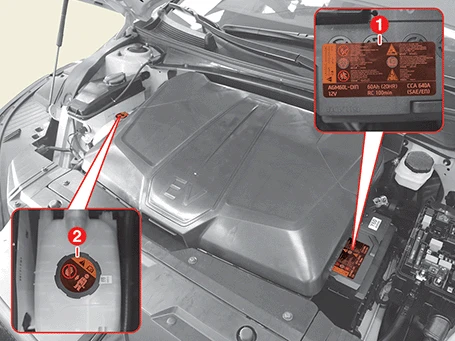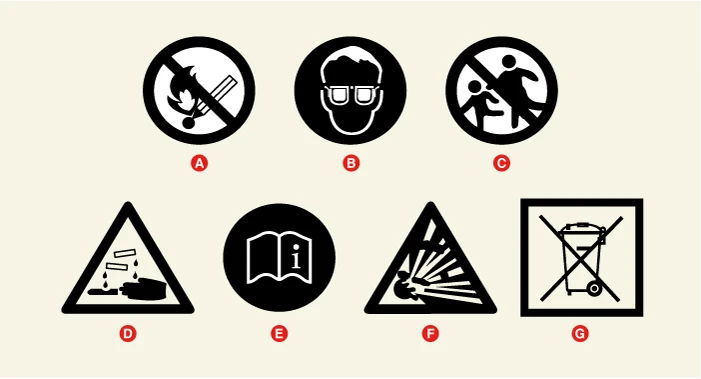Warning And Caution Labels

1. Battery caution label
2. Pressure cap caution label
Auxiliary Battery Caution Label

A.No flames
B.Wear eye protection
C.Prohibit access of children
D.Caution battery electrolyte
E.Information manual
F.Explosion caution
G.Waste recycling
Precautions for handling batteries

You must be aware of general safety precautions when installing, re-charging or handling the battery. Failure to handle the battery may result in explosions, suffocation or addiction.
• Wear eye protection, Insulated gloves, and protection masks.
• Keep lighted cigarettes and all other flames or sparks away from the battery.
• Do not intentionally disassemble the battery.
• Be sure to keep the battery in the horizontal position when storing, handling or carrying it.
• Do not work around the battery while it is re-charging or discharging.
• Always provide ventilation when working in an enclosed space.
• Be careful of flames which occurs due to the short circuit while working with metal tools or conductors.
• If any electrolyte gets into your eyes, flush your eyes with clean water for at least 15 minutes and get immediate medical attention.
• If ingestion of electrolyte occurs, drink large amounts of water or milk and take a medical care quickly. Do not induce vomiting.
• Check if the charging cable is damaged when charging the battery. Charging the battery with damaged cable may cause explosion or battery health dicrease.
• If the battery becomes hot while charging, there can be explosion risk due to the generation of gas. Decrease the charging voltage or stop charging.
How to store the battery
| Handling and storage | Store the battery in a cool, dry place and keep away from direct sunlight.
|
• Store the battery when removing from the vehicle.
• Check if the battery is fully charged and perform additional charging every 2 months.
• Remove the corrosion on terminals and connectors by brushing with the mixture of baking soda and water to prevent the deterioration of the battery due to storing it in corrosive condition.
• Before installing, apply the grease on the battery to reuse it.
Vehicle parked for an extended period of time
Disconnect the battery from the vehicle and charge the battery as much as possible.
Store the fully charged battery in cool and dry area. If the battery is fully charged, it can be stored below 0 ºC (32 ºF ), but if not it can be frozen.
Regular operating vehicle
Check if the battery is leaking, damaged or cleaned regularly.
Check the charging status of the battery regularly.
Inspect the vehicle when the battery is discharged or overcharged.
If the battery performance deteriorates, replace the battery.
